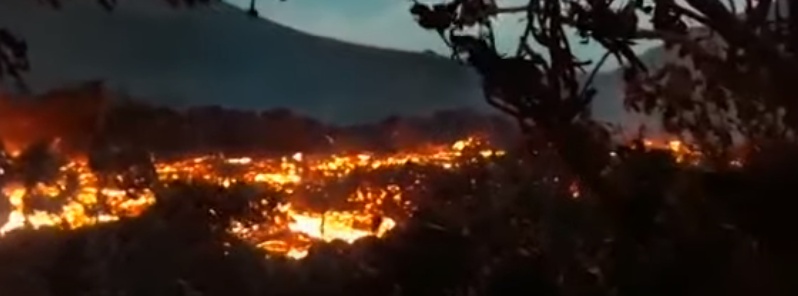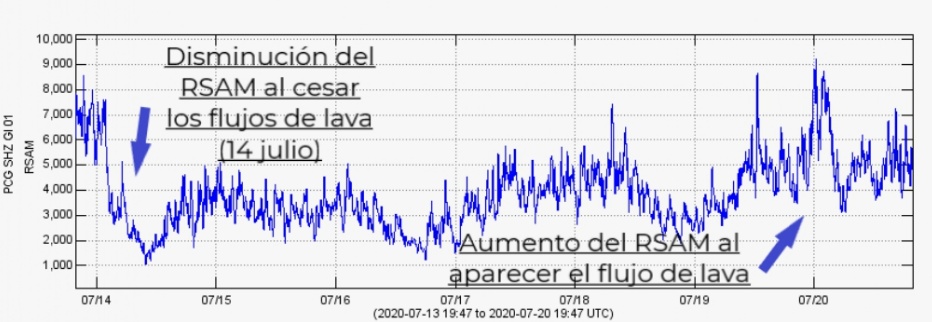Strong strombolian activity at Pacaya, new lava flows and blue fumaroles observed, Guatemala

Strong strombolian activity continues at the Pacaya's Mackenney crater in Guatemala, the National Institute of Seismology, Volcanology, Meteorology, and Hydrology (INSIVUMEH) reports. The volcano is producing lava flows after several quiet days and ejecting volcanic material up to 100 m (330 feet) above the crater. White and blue fumaroles were also observed.
The National Coordination for Disaster Reduction (CONRED) visited the site recently and identified a new rupture generated in the lava deposits that the volcano produced weeks ago. This has caused the fumarole to turn blue, it said.
Seismic stations registered new tremors associated with the rise of magma and gas.
While no new lava flows were observed from July 14 to 19, a new flow was recorded on Monday morning, July 20, due to an increase in the energy released compared to the past days. The lava flow did not come from the crater area, but from the northwestern base of the cone, in front of Cerro Chino, flowing in a south-eastern direction.

Three flows were observed on July 21, up to 300 m (984 feet) long in the northwest direction.
INSIVUMEH warned that new flows can be generated again at any time and advised residents and tourists to stay away from the volcano and previous lava flows.
CONRED said the activity at Pacaya is being monitored along with INSIVUMEH, and reports are received daily from various local coordinators for disaster reduction.
El volcán Pacaya ha presentado flujos de lava desde semanas atrás, esta actividad se esta monitoreando en conjunto con el INSIVUMEH y diariamente se recibe reportes de las diferentes Coordinadoras Locales para la Reducción de Desastres -COLRED-. 2/2 pic.twitter.com/AxlWl29z0u
— CONRED (@ConredGuatemala) July 20, 2020
Actividad Efusiva del Volcán Pacaya 1/3 pic.twitter.com/HuPGgBrvLc
— William Chigna (@William_Chigna) July 21, 2020
La actividad del volcán se mantiene con bastante efusión de lava pic.twitter.com/ib2bIBThgG
— William Chigna (@William_Chigna) July 21, 2020
Geological summary
Eruptions from Pacaya, one of Guatemala's most active volcanoes, are frequently visible from Guatemala City, the nation's capital. This complex basaltic volcano was constructed just outside the southern topographic rim of the 14 x 16 km (8.7 x 9.9 miles) Pleistocene Amatitlán caldera. A cluster of dacitic lava domes occupies the southern caldera floor.
The post-caldera Pacaya massif includes the ancestral Pacaya Viejo and Cerro Grande stratovolcanoes and the currently active Mackenney stratovolcano.
The collapse of Pacaya Viejo between 600 and 1 500 years ago produced a debris-avalanche deposit that extends 25 km (15 miles) onto the Pacific coastal plain and left an arcuate somma rim inside which the modern Pacaya volcano (Mackenney cone) grew.
A subsidiary crater, Cerro Chino, was constructed on the NW somma rim and was last active in the 19th century.
During the past several decades, activity has consisted of frequent strombolian eruptions with intermittent lava flow extrusion that has partially filled in the caldera moat and armored the flanks of Mackenney cone, punctuated by occasional larger explosive eruptions that partially destroy the summit of the growing young stratovolcano. (GVP)
Featured image credit: Noti7 (still shot)

Commenting rules and guidelines
We value the thoughts and opinions of our readers and welcome healthy discussions on our website. In order to maintain a respectful and positive community, we ask that all commenters follow these rules.